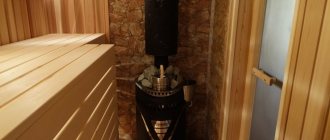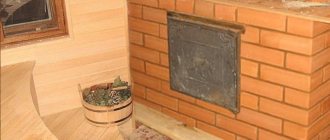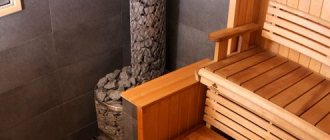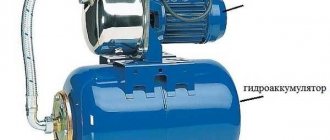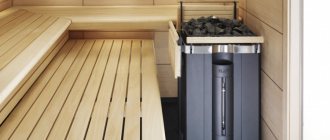A steam gun for a sauna stove is a device designed to supply water to the hottest part of the stove in order to obtain the dryest, finely dispersed steam. It is usually made of metal pipes, which are located inside the heater in such a way that water can be poured in at one end and steam can be obtained at the other.
There are designs that provide for the second end of the pipe to be brought out, and others are designed in such a way that all the water poured into the heater remains there to completely evaporate upon contact with overheated stones.
Direct the steam gun to the bottom of the oven
The very name “steam gun” appeared due to the fact that steam should be formed not just in some space, but in a pipe or channel. And the stream of steam itself should not just evaporate, but also fly out under pressure. The pressure in the gun is not generated by chance. We create it when we close off steam in a confined space. “Stopping the steam in the cannon” is the main task. This is the only way it can not only form, but also overheat, obtaining an increasingly finer structure. Superheated steam becomes light!
Many bathhouse lovers share their developments on forums. Those who have access to specialized equipment create complex designs of channels and funnels from stainless steel. Kulibins - homemade ones use simply pieces of pipes and iron mugs for this purpose. Personally, I tend to use a piece of pipe with holes in it and a valve to prevent the steam gun from escaping back into the water funnel.
I will give a comparative analysis of a complex factory product of a steam gun and a homemade pipeline - a steam generator.
Advantages of a complex steam gun
- Increased surface area for steam generation, a large number of channels and holes for steam release, which allows you to evenly distribute steam flows throughout the entire volume of the heater
- Impeccable quality of construction seams of the product
- Great design
- Convenience of a steam gun funnel for supplying water
Factory steam gun - disadvantages
- The complex design does not allow it to be equally easily installed in any sauna stove. This is due to different design solutions for the bottom and roof of the firebox. Ideal stoves for steam guns are stoves with a flat bottom, which is also the arch of the firebox. And there are very few such stoves.
- Expensiveness is another big stone in the garden called a steam gun for a bath
- The inability to remake the design and conduct experiments with the installation, incl. and when replacing a sauna stove.
Homemade steam gun for a sauna stove 1. Pipe 2. Lid nut 3. Stainless steel glass or watering can 4. Connection nut 5. Non-return steam valve
Homemade steam cannons from pieces of pipes
- These are perhaps the only solutions that allow you to be ideally adapted to the design of any furnace
- The possibility of using non-ferrous metal waste and Chinese household mugs and stainless steel funnels ensures a low manufacturing price, as they say, “on the knee”
- Easy placement of stone near a simple pipe structure and bringing the injection holes as close as possible to the metal bottom of the heater, i.e. to high surface temperatures.
How does a steam gun work?
The main task of the gun is to deliver hot water (preferably boiling water) to the bottom of the heater with minimal contact with the surface of the gun itself. Why? It's simple: the gun itself, being inside the heater, heats up along with the stone and does not always have a high temperature, like the bottom of the stove. More precisely, it never gets as hot as the bottom. If water flows slowly inside the gun channels. Then it will slowly evaporate on the not very hot walls of the device. As a result, we get non-dry steam inside the tubes. If there are many exit holes or there is no shut-off valve for this steam, then this steam may not get to the bottom of the heater and fly out wet onto the stones. Go up to the steam room. Therefore, the best steam gun is one that is equipped with a steam valve. The valve does not allow steam to escape freely into the area of the inlet funnel and steam under pressure, lingering inside the metal structure, rushes into the holes directed towards the bottom of the heater. And the closer to the bottom, the higher the temperature. The already prepared steam, once again falling on the steel bottom of the furnace or stone, is further broken into parts and turned into light steam. At the same time, the valuable energy of the stone is not wasted on the vaporization process itself, and the stone does not cool down as quickly as if water was simply splashed on it.
The ideal option for calculating the parameters of a steam gun is when steam is formed inside the tubes and flies out and hits the stone and bottom. An equally good option is when steam is generated from boiling water pouring onto the bottom of the heater. The steel instantly cools, but manages to form steam, which, rising upward, through the stones, is heated and overheated.
Ideal conditions for operating a steam gun
- Supply of boiling water into the funnel for minimal cooling of the gun structure
- Creating pressure inside the steam generator, which prevents the free release of steam from the tubes in its raw form. Presence of a check valve
- Maximum proximity of the steam gun tubes to the bottom of the heater
- Possibility of adding aromatic oils to steam
On the Internet you can also find steam guns for baths that do not live up to their name.
Here is an example of such a device. In practice, it is useless as a cannon and pretends to be only a water flow divider, and even then with great stretch. Water simply hits the stone closer to the bottom of the firebox. Homemade steam generators made from a piece of pipe are easier to clean from scale than complex angular structures.
Of course, the ideal option is steam guns with water supply dispensers, made at the sauna stove manufacturer. They take into account all design features and create the longest heating channel for steam. The presence of a dispenser makes it possible to constantly supply steam during the entire vaping time. But the point is precisely that superheated steam can be obtained more easily during a “salvo.” A volley can also be organized by supplying water to a closed heater. It is not uncommon for a splash of steam to result in foil noise and the doors to the steam room opening due to the resulting impact.
What determines the quality of steam?
You've probably heard from bathhouse attendants with extensive practical experience that steam can be “heavy,” “damp,” “light,” “muslin,” “viscous,” and so on. Its quality determines the comfort of staying in the steam room and the sensations from the procedures. A strict rule has been established: the higher the air temperature in a steam room, the lower the absolute humidity should be.
For example, a dry-air bath, which some mistakenly call a Finnish sauna, often has an air temperature of about 105 - 120 degrees Celsius. It is quite natural that air humidity at such temperature values should not exceed 15% in absolute terms, otherwise a comfortable stay in such conditions, even for a trained and seasoned person, cannot be achieved. On the other hand, there are purely steam baths, of which the oriental hammam is a prominent representative. Here the situation is the opposite.
Absolute air humidity is 85% and higher, up to 100%, however, the air temperature here is quite low, about 45 degrees Celsius. Of course, the tastes of bathhouse lovers are very diverse and contradictory, and there is a generally accepted ratio of the so-called “golden steam”, or rather the most comfortable average balance of temperature and humidity. But to achieve it, it is necessary to clearly and accurately regulate the vaporization process.
Principles of generating high-quality steam
Bathhouse old-timers will unanimously say that high-quality steam should be:
- Light and transparent. Among bath aesthetes there was even an appropriate expression for it - “muslin steam”;
- Confidently form a completely tangible “steam cake” under the ceiling of the steam room, from which, as needed, with confident movements of a bath broom, portions can be taken and distributed among the shelves or the internal volume of the steam room as a whole. In German baths there is even a position of “bath conductor” for this purpose;
- Finely dispersed. It is the fine fraction of water vapor that determines its permeability and airiness. It does not burn the bronchi; being in such a steam cloud is easy and comfortable. The dispersion of steam depends on many factors: the temperature of the contact surface, the thermal conductivity and heat capacity of the material, the contact area, the uniformity of temperature zones in the volume of the heater stove, and so on.
Important! Many people have probably heard quite critical reviews about the quality of steam generated by purely metal furnaces or metal backfill in the form of cast iron balls. They say that such steam is very hard, flat, and does not have the volume and depth that is so revered by connoisseurs. Such steam even has the smell and taste of burnt metal, iron scale, which does not add any pleasant sensations.
The higher the temperature of the sauna stove stone, the larger the contact area, the more developed the heat capacity of the stone backfill, the correspondingly greater the chances of obtaining steam of acceptable quality. However, what we have in reality:
- Most stone baskets have a very heterogeneous heating structure for the entire volume of stone. At the bottom, the stone is more heated than at the top, which is in contact with water during steam formation. Insufficient temperature of the upper part of the heater provokes the generation of coarse heavy steam.
- It takes time and fuel to warm the entire volume of the stone basket to the required temperature. This point is especially relevant for stoves with a large amount of material in the heater.
- Even if water gets on the well-heated lower layers, the steam rising upward will pass through the thickness of the stone with insufficient temperature and again lose its condition.
Attention! Do not forget that the recently popular mixes for forming stone backfill consist of several types of minerals, which can differ significantly from each other in a number of thermodynamic characteristics. Accordingly, the processes of vaporization on their surface will differ.
Manufacturing recommendations
At the stage of developing a drawing of a home-made unit, it is necessary to ensure that the largest possible area of metal water outlets comes into contact with the stove stones. To do this, the pipes must be placed at a minimum distance from the stones.
The simplest device
Even when using a simple steam generator, the bath will have the most comfortable temperature. A home craftsman will be able to make an effective unit with minimal investment. For this, in addition to the stove, you will need the following materials:
- 2 corrugated pipes of larger cross-section;
- porcelain balls that are placed in the stove;
- 2 corrugated pipes of smaller diameter.
First, it is necessary to make holes equidistant from each other with a diameter of 8 to 10 mm in two pipes of a larger cross-section. You will also need to bend both ends of the pipe towards the small holes. These structural elements are placed with the holes facing up on the bottom of the stove opposite each other. Then you need to insert liquid supply pipes with funnels into their bent ends. Having completed these steps, all that remains is to completely fill all the free space of the oven with porcelain balls.
Finnish sauna
Since in an electric furnace the space at the bottom does not heat up very much, a vessel with holes can be placed there, for heating which heating elements are used. However, if the stove has small dimensions, then it is better to use a copper tube with holes instead of a container.
The stones located around the pipe will heat up to approximately +130...+180°, and the liquid will evaporate, forming a sufficient amount of steam. Since the steam will take a certain time to overcome the layer of stones, its temperature will become optimal for the steam room.
There is no need to install a check valve in such a unit. This is due to the fact that a small-section copper tube has a small heated mass compared to the volume of liquid passing through it. It is water that will serve as a safety device.
A distribution pipe with holes can be purchased or made independently. Then you need to solder a long tube of smaller diameter, also made of copper, to one end. The connection must be of the highest quality, since the device will be placed at the bottom of a hot stove.
A funnel is attached to the second end of the long tube into which the liquid will be poured. At this point, the process of manufacturing a steam gun can be considered almost complete. All that remains is to lay the distribution pipe on the bottom of the furnace and then fill it with stones.
If the owner of a bathhouse does not require various additional functions that factory products have, then it is quite possible to independently make a simple steam generator for a bathhouse with your own hands. With its help, you can achieve maximum comfort in the steam room without investing a large amount of money.
What to do with all this?
The tens need to be strengthened in the canister, or rather, placed inside it. And to do this, holes of the appropriate diameter should be drilled in the canister body. From the inside of the canister (through the large lid) we insert a heating element into them, seal it and secure it well. In a word, we remember a boiler immersed in water and do it by analogy!
After the heating elements are inside, you need to connect their electrical terminals to the wire outside, and the contacts should be securely wrapped with electrical tape and protected from accidental touch. One stage of the work has been completed, congratulations, you did it!
Description of the unit
The healing properties of steam can occur under certain conditions. This is why many people use a steam generator for a sauna stove.
Design Features
A classic steam generator for a bath is a unit in which an electric heating element is installed. Its operating principle is reminiscent of an electric kettle - water is poured into the device, the heating element is turned on, which leads to the formation of steam. A valve is mounted on the lid of the device to regulate the pressure. This way you can create steam at the required temperature and humidity.
In this video we will look at which steam generator for a bath is better:
The design of the factory unit assumes the presence of the following elements:
- security sensor;
- container for liquid;
- water treatment unit;
- steam generator;
- pump;
- Remote Control.
The steam generator is equipped with a display that displays various information about the operation of the unit.
Main types
Water can be poured into the device manually or automatically. In the second case, a homemade steam generator for a bath needs to be connected to the water supply. Today, most models are equipped with an automatic room temperature control system.
Types of steam generators:
- Industrial ones are used in public baths and saunas.
- Household ones are characterized by low power and are intended for use at home.
Depending on the method of heating water, devices can be divided into 3 types:
- Electrode - the liquid is heated by an electric current passing through the electrodes.
- Heating element - water is heated using special devices - heating elements.
- Induction - the operating principle is similar to a microwave oven.
Electrode steam generators have the simplest design.
Step by step steps when using a gas cylinder
- A heating element is inserted into the bottom of the selected container at a distance of about 10-15 mm from the bottom. When installing several heating elements, it is better to first cut in and secure one, and then drill the following holes to prevent them from being too close. If you have to weld a sleeve to install a heating element, the design of the unit must withstand high pressure. The heating elements are sealed using heat-resistant gaskets on both sides of the opening. It is necessary to provide for the possibility of free removal of the heating element when replacing it in case of failure.
- Squeegees are welded to the cut-off cover for connecting control devices (contact pressure gauge with arrows, safety valve). You can combine them together (safety group), then only one hole is used.
- At a distance of 10 cm from the bottom of the cylinder, a water supply pipe is inserted. The container with water from which it will be supplied to the steam generator is made of translucent plastic and connected to the device with a hose made of heat-resistant material. This way you can easily control the amount of incoming water.
- Another method can be used to determine the water level inside, but it will require more holes. The tap pipe is welded to the side. It must be placed below the required upper level by 1-1.5 cm. When filling with water, the tap opens and water flowing out of it is a signal for the end of filling. It is necessary to ensure that the tap is turned off before turning on the steam generator.
- The valve for steam release will be the standard cylinder valve. It connects to the steam line. To prevent steam from escaping in a narrow stream, you can install a 50 cm long steel pipe with numerous holes made on it for dispersion.
- A lock is installed on the upper edge of the cylinder, ensuring tightness using a rubber seal.
- The lid and the lower part are connected using L-shaped studs and nuts.
It is much simpler to make a hermetically sealed connection between two parts - weld them, but then the device will be beyond repair.
The designed device must be tested in action to identify and eliminate deficiencies.
Types of steam generators
If we want to get faster access to the steam generation mode, more flexible methods of process control, then we should pay attention to steam sources of a slightly different nature. Almost all of them use electric current as a source of thermal energy.
Based on heating elements
A heating element - a tubular electric heater - is widely known in everyday life. Electric kettles, washing machines, boilers carry it as a source of thermal processes. The main disadvantage of such devices is the tendency to form lime deposits on the metal contact surface, which in turn reduces the efficiency of its heat transfer. The use of heaters with a ceramic body promises some reduction in the severity of the problem, but they are significantly more expensive than metal ones.
The second thing you should pay attention to is constant monitoring to prevent the water in the generation chamber from falling below the minimum level. As soon as a heating element of this type is exposed, it immediately overheats and fails, due to the physical destruction of the conductive circuit. Otherwise, steam generators using heating elements are very popular and find the widest application: from compact saunas to artisanal workshops for producing counterfeit alcohol - live steam is very convenient for boiling and saccharifying starch-containing raw materials.
Electrode systems
In this case, heating of water occurs due to the active movement of elementary particles between the cathode and anode. The danger of overheating and failure of the current-carrying circuit does not exist here in principle. The water itself acts as a conductor of current. There it is in the chamber - the circuit is closed, the process has begun. Evaporated - the steam generation process automatically ended and energy consumption stopped. Manufacturers of such equipment promise a higher efficiency of such units and increased operating safety.
Induction heaters
One of the most high-tech examples of superheated steam production. In everyday life, an analogy can be drawn with a microwave oven. Cheburek or pizza is heated in a kitchen unit without visual processes - quickly and efficiently. In industry the effect is even more significant.
Using induction installations, heat treatment of metal parts is carried out in a short period of time, heating a product weighing several tens of kilograms to red heat. The operation of induction systems is based on the ability to heat a substance in a field generated by high-frequency currents. Simply put, the operating principle of such a device is to transfer magnetic field energy to the coolant.
By the way! The design elements of a vortex-type induction heater are mounted externally, which to some extent eliminates the occurrence of leaks and simplifies installation and maintenance of the system.
A do-it-yourself steam gun for a bath, the diagrams of which we have given, is most easily implemented through the use of heating elements, since both the induction and electrode heating principles require a responsible approach to implementation, supported by fundamental knowledge in the field of electrical engineering. Examples of the implementation of simple assemblies of steam generators for a bath can be seen in the video materials attached to this article.
FAQ
I bought a Feringer stove, but I'm not very happy with it. Takes too long to warm up. Can I somehow fix it?
The use of damp firewood leads to prolonged heating. The resulting steam sharply reduces the flame temperature, and heat transfer to the underlying layers is slow.
The combustion tunnel of the Feringer Classic stove heats up red-hot. This is fine?
No. Firewood is burning in the tunnel, but this should not happen. They should lie in the combustion chamber, up to the side. The tunnel itself is made of less alloyed metal and is not designed to withstand open flame temperatures. Over time, he may be led away.
To warm up the steam room to 70 degrees, I heat the stove for up to 8 hours. Is it possible to somehow fix it, that is, speed up the warm-up?
The reason may be that the stone is laid too tightly. Close the damper by a quarter as soon as the fire is well lit. Open the stone blower and remove the phytocontainer.
How to choose a quality steam generator?
Let's first understand: what is the efficiency of a steam generator? This is the amount of steam it produces per hour, its power and calculation for the steam room room. And the steam generators themselves are different. So, for private baths and saunas they are produced with a power of 4-12 kW, but for public steam rooms they are much more powerful - even for a voltage of 380 Volts.
So, for a small steam room of 5-6 cubic meters, a steam generator with a power of 4-5 kW is quite enough, but for a room with a volume of 10-12 cubic meters, the parameters are already needed within the range of 8-10 kW. For large steam rooms of about 18 cubic meters, only a steam generator with a power of at least 12 kW is suitable.
Even modern steam generators are autonomous and automatic in connection method. You need to fill the first ones with water, while the second ones are themselves connected to the water supply system. It would seem, why is the second option bad, and why then the first? The fact is that there are so many impurities in our pipes that scale cannot be avoided, and therefore sometimes it is better not to be lazy and pour in clean water purchased or pulled from a well yourself.
Models
Feringer sauna stoves are divided into 2 types: stone and metal.
Metal ones are suitable for budget steam rooms. But if you want to feel the full effect of a Russian bath, there is only one way out - choose a stone. The cladding completely eliminates infrared radiation from users. You cannot get burned from the furnace body. The only downside to the stoves is the price. A stone-clad stove with the cheapest stone costs on average three times more.
Metal stoves are made from exactly the same metal and thickness. Everything is identical except for the missing stone. Great respect to the founder of the company that he does not skimp on budget stoves, but produces the same quality ones from metal as from stone.
In terms of power, there are three options for stoves designed for different volumes of steam rooms:
Baby – 8-16 cubic meters/m
Classic – cubic/m
Harmony – 12-30 cubic meters/m
In 2011, a new line of stoves appeared - Lamel. It is distinguished by the presence of natural stone cladding. Some changes have been made to the design, allowing you to confidently heat steam rooms in log houses from sub-zero temperatures.
The stone fastening system of the new models is interesting: a holder with hooks is mounted on the stone cut into plates, with which the lamellas are fixed in a special groove. The system is simple but effective, and installation is very easy.
Baths, saunas and swimming pools
To generate the required volume of steam in the bath, special equipment is used, which is called a steam generator or steam gun. Such a device can be purchased in stores, and if you wish, you can make it yourself, having understood in detail the basic principles of the device, its types and features. Read further in the article about the features of making and installing a steam generator with your own hands.
Table of contents:
- Types of steam generators and their purpose
- Steam generator design
- Types of steam generators, furnace or electric
- What tools and materials are needed to make a steam generator with your own hands?
- How to properly install a steam generator in a mini steam room with your own hands
- Choosing a suitable container or heating element for a steam generator with your own hands
- Steam generator from a gas cylinder manufacturing features
Types of steam generators and their purpose
A steam generator in a bathhouse can function in conjunction with stove equipment, and also serve as an independent device. This type of device is very popular due to the well-known healing properties of steam, which has a good effect on the general condition of the body, skin, etc. Modern stores offer a wide range of different household and industrial steam generators, which differ in size, method of filling water, power and type of water heating. Ready-made models are equipped with a special control panel that allows you to control the temperature of the steam, as well as the amount of steam supplied.
Industrial steam guns are intended to serve public baths. Household steam generators find their use in private baths, saunas and hammams.
| Types of steam generators according to the method of heating water | |
| Electrode | In this case, the water is heated by electrodes that transmit current. During operation, such steam-generating devices do not overheat and produce absolutely environmentally friendly steam, purified from various impurities, salts, etc. accumulations present in water. |
| Electric | Electric water heating (TEH) is provided by heaters that vary in power level. They are chosen based on the size of the room. For example, for small-sized steam rooms, 4-6 kW devices are recommended, for medium-sized ones, 8-9 kW guns are optimal, for large rooms it is worth using equipment with a power of 12 kW or more. |
| Induction | Water is heated by the action of an electromagnetic field, resulting in the release of light, purified steam. Such steam generators are quite expensive, which is considered one of the disadvantages of this type. |
All pore formers are divided into automatic and autonomous. The former do not require regular, manual filling of water, as they are equipped with automatic control and connected to the water supply system. The latter, on the contrary, require manual intervention, since there is no running water. Autonomous steam generators have a more affordable price and, as a rule, are distinguished by a large, volumetric bowl for filling liquid.
Steam generator design
The simplest steam generator is a rectangular body made of metal. The interior of the device consists of:
- water containers;
- pumps (water and steam);
- temperature sensor;
- evaporation chambers;
- nozzle;
- heating element.
On the outside, the steam gun is equipped with a pipe through which you can connect the water supply. To drain water, special taps are installed in the devices. When starting to make a steam generator with your own hands, it is important to take into account that the material for the evaporation chamber must have heat-resistant properties. Additionally, the steam generator can be equipped with a control panel and even organize a time interval for the working process, which will turn the device into a multifunctional steam system.
Types of steam generators, furnace or electric
The steam generator is called the heart of the bathhouse, sauna and hammam. Many lovers of steam leisure do not recognize devices that emit steam, but at the same time function independently, that is, without heat transfer from the stove. They believe that steam generated by electrical self-generation is artificial and less effective in influencing the human body. However, professionals claim that electrical devices intended for baths are fully capable of satisfying human needs regarding healing through steam procedures.
A steam generator is, first of all, a device that allows you to control the heat and amount of steam released in the steam room as accurately and efficiently as possible. As practice shows, conventional heater stoves without steam generators, if not properly managed, can emit steam that is too hot or not humid enough, in turn, the integrated operation of these devices completely eliminates this type of problem in the bathhouse.
The process of operating a wood stove with a steam generator is as follows:
1. The required amount of liquid is poured into the container under water.
2. Water travels its way to the point where steam is generated.
3. Due to the heating of the oven, under the influence of the desired temperature (more than 650 degrees), the water evaporates through specially made holes in the device.
Such devices for steam generation do not require additional manual intervention, such as adding water to stones, etc.
At home, they most often resort to making electric steam generators. To do this, use either used gas cylinders, or pressure cookers and other improvised materials. More detailed instructions will be provided later in the article.
What tools and materials are needed to make a steam generator with your own hands?
To make steam generators with your own hands, it is best to use a material that can withstand high temperatures. Stainless steel is just such an option. As for the working tool, in the process of manufacturing a steam generator, the master cannot do without:
- hammer;
- roulette;
- drills;
- welding machine;
- Bulgarians;
- self-tapping screws;
- metal scissors;
- electrical tape;
- adjustable and plumbing wrenches;
- set of drills, etc.
To carry out initial testing of steam generators, the technician will need a thermometer.
How to properly install a steam generator in a mini steam room with your own hands
Mini steam rooms, small Turkish baths, herbal barrels - these are, in fact, small rooms that function according to the same principle, a closed space with regularly released steam. Due to the minimal size of the steam room, the presence of heater stoves in such mini-steam rooms is practically impossible, which encourages the use of devices such as steam generators, which can be made with your own hands even from a plastic canister. For example, to heat a small phyto-barrel, which is a wooden box with a place to sit inside, a low-power steam generator will be sufficient. To make it, you need to purchase a metal hose, about 2 meters, and a tee fitting from a plumbing store. Additionally, you will need a metal-plastic pipe, sealants, electrical tape, a drill, a heating element, an electrical wire and a plastic canister with a capacity of 5 -10 liters.
A heating element is mounted at the bottom of the canister, which must be properly sealed and secured. In fact, this turns out to be a stationary boiler. An electric wire is attached to the heating element; insulating tape should be used at the contact points to prevent spontaneous electric shocks.
In order to install a homemade steam generator in a mini steam room or phyto-barrel, using a drill and drills of suitable size, holes are made in the lower part of the barrel. They will be needed to connect a metal-plastic hose from the steam generator to the steam room, which is connected to the tee fitting and directly to the water pipe. For safety and control, it is recommended to install thermometers in mini steam rooms.
Choosing a suitable container or heating element for a steam generator with your own hands
Inventing steam generators with your own hands is an interesting business, requiring ingenuity and some calculations. One of the possible containers that can be used to construct a steam-generating device has already been mentioned above (plastic canisters). Gas cylinders, pressure cookers, etc. are also used for this purpose. The choice of container mainly depends on the dimensions of the steam room, while professionals and experienced craftsmen do not recommend making steam generators of their own production with high power.
As for the heating element, the most common are electric heating elements, which are sold in stores in various forms, models and power levels. Some craftsmen manage to use heating parts from old electric kettles in homemade steam generators. When installing them, you should be quite careful and seal all holes with special heat-resistant gaskets made of silicone or genuine leather.
Features of assembling a solid fuel steam generator for a home using wood or coal
Assembly of a solid fuel steam generator is much simpler compared to its electric counterpart, and less expensive. The design will require pipes of various diameters. First you need to make a loading tank, for which you can use a pipe with a diameter of 300 mm. It burns coal or wood. It is also necessary to weld a water container that is installed above the firebox. A register pipe and an adapter should be welded to it, through which the steam will be discharged outside. For more information on how to make a steam generator with your own hands, watch the video.
Video “Features of assembling a solid fuel steam generator with your own hands”:
Distinctive features
Feringer stoves correspond to real stone stoves.
Absolutely all devices have distinctive branded features:
- burning from top to bottom;
- air is supplied through separate channels at the top of the heat-resistant door;
- The stoves do not have a grate or an ash pan.
Sauna and steam bath stoves have several modes:
- Finnish dry sauna - work with an open valve;
- express drying of a steam room - with an open valve and a strong fire;
- Russian stove - with a closed valve, direct contact of the air with the stone lining of the unit;
- Blowing the heater - to regulate the power of hot air.
Customer Reviews
Marina Alekseeva: “The Feringer brand Mini stove burned out after 3 years. The steam was good, but such a low-quality device is not worth the money; it burns out very quickly. It is better to buy cast iron and also in stone. By the way, you need firewood of a certain size, not too big.”
Sergey Ivanovich: “Fehringer Optima has a number of advantages, and most importantly, installation yourself will not take much time. I installed the stove at my parents’ summer cottage, everyone is happy. The cast-iron body retains heat well, which saves on fuel.”
Igor Kuznetsov: “We have a Feringer stove, a subtype of Maxi, which can only be installed in large rooms, approximately 30 cubic meters. It's been in service for probably 7 years now. Not only the stone decor is interesting, but also the quality of the unit - for several years now, every weekend we have been going to steam with friends, the stove is still working properly.”
